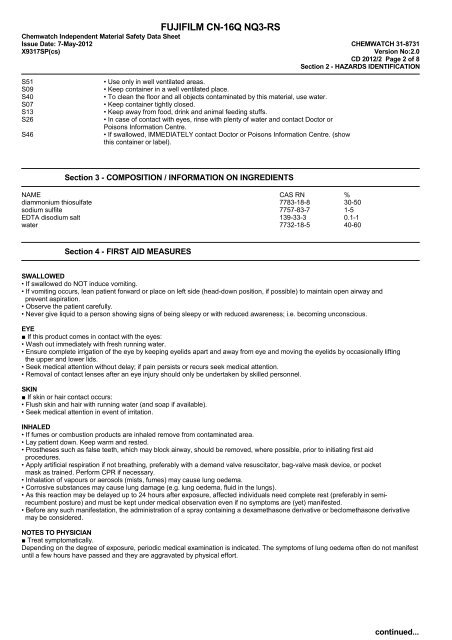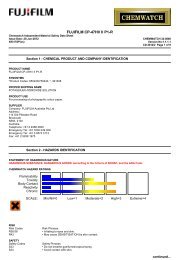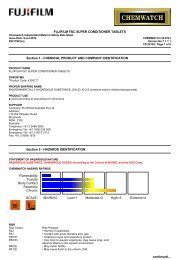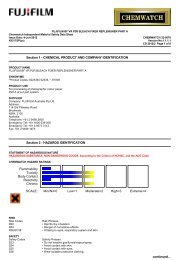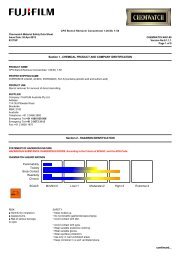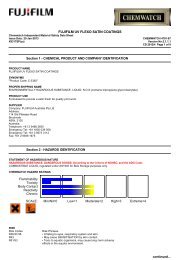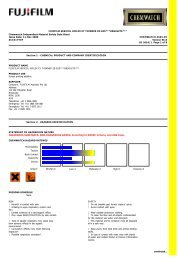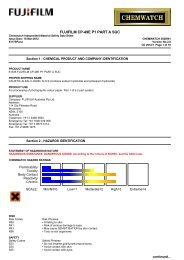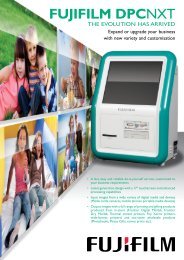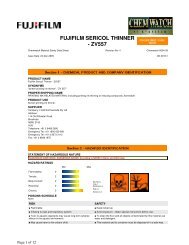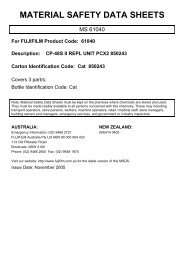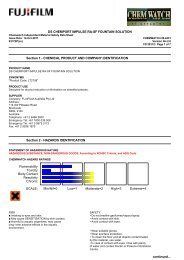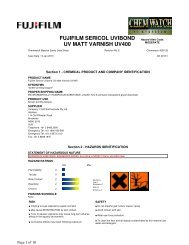Chemwatch Australian MSDS 31-8731 - FUJIFILM Australia
Chemwatch Australian MSDS 31-8731 - FUJIFILM Australia
Chemwatch Australian MSDS 31-8731 - FUJIFILM Australia
Create successful ePaper yourself
Turn your PDF publications into a flip-book with our unique Google optimized e-Paper software.
<strong>FUJIFILM</strong> CN-16Q NQ3-RS<br />
<strong>Chemwatch</strong> Independent Material Safety Data Sheet<br />
Issue Date: 7-May-2012 CHEMWATCH <strong>31</strong>-87<strong>31</strong><br />
X9<strong>31</strong>7SP(cs)<br />
Version No:2.0<br />
CD 2012/2 Page 2 of 8<br />
Section 2 - HAZARDS IDENTIFICATION<br />
S51<br />
S09<br />
S40<br />
S07<br />
S13<br />
S26<br />
S46<br />
• Use only in well ventilated areas.<br />
• Keep container in a well ventilated place.<br />
• To clean the floor and all objects contaminated by this material, use water.<br />
• Keep container tightly closed.<br />
• Keep away from food, drink and animal feeding stuffs.<br />
• In case of contact with eyes, rinse with plenty of water and contact Doctor or<br />
Poisons Information Centre.<br />
• If swallowed, IMMEDIATELY contact Doctor or Poisons Information Centre. (show<br />
this container or label).<br />
Section 3 - COMPOSITION / INFORMATION ON INGREDIENTS<br />
NAME CAS RN %<br />
diammonium thiosulfate 7783-18-8 30-50<br />
sodium sulfite 7757-83-7 1-5<br />
EDTA disodium salt 139-33-3 0.1-1<br />
water 7732-18-5 40-60<br />
Section 4 - FIRST AID MEASURES<br />
SWALLOWED<br />
• If swallowed do NOT induce vomiting.<br />
• If vomiting occurs, lean patient forward or place on left side (head-down position, if possible) to maintain open airway and<br />
prevent aspiration.<br />
• Observe the patient carefully.<br />
• Never give liquid to a person showing signs of being sleepy or with reduced awareness; i.e. becoming unconscious.<br />
EYE<br />
■ If this product comes in contact with the eyes:<br />
• Wash out immediately with fresh running water.<br />
• Ensure complete irrigation of the eye by keeping eyelids apart and away from eye and moving the eyelids by occasionally lifting<br />
the upper and lower lids.<br />
• Seek medical attention without delay; if pain persists or recurs seek medical attention.<br />
• Removal of contact lenses after an eye injury should only be undertaken by skilled personnel.<br />
SKIN<br />
■ If skin or hair contact occurs:<br />
• Flush skin and hair with running water (and soap if available).<br />
• Seek medical attention in event of irritation.<br />
INHALED<br />
• If fumes or combustion products are inhaled remove from contaminated area.<br />
• Lay patient down. Keep warm and rested.<br />
• Prostheses such as false teeth, which may block airway, should be removed, where possible, prior to initiating first aid<br />
procedures.<br />
• Apply artificial respiration if not breathing, preferably with a demand valve resuscitator, bag-valve mask device, or pocket<br />
mask as trained. Perform CPR if necessary.<br />
• Inhalation of vapours or aerosols (mists, fumes) may cause lung oedema.<br />
• Corrosive substances may cause lung damage (e.g. lung oedema, fluid in the lungs).<br />
• As this reaction may be delayed up to 24 hours after exposure, affected individuals need complete rest (preferably in semirecumbent<br />
posture) and must be kept under medical observation even if no symptoms are (yet) manifested.<br />
• Before any such manifestation, the administration of a spray containing a dexamethasone derivative or beclomethasone derivative<br />
may be considered.<br />
NOTES TO PHYSICIAN<br />
■ Treat symptomatically.<br />
Depending on the degree of exposure, periodic medical examination is indicated. The symptoms of lung oedema often do not manifest<br />
until a few hours have passed and they are aggravated by physical effort.<br />
continued...


